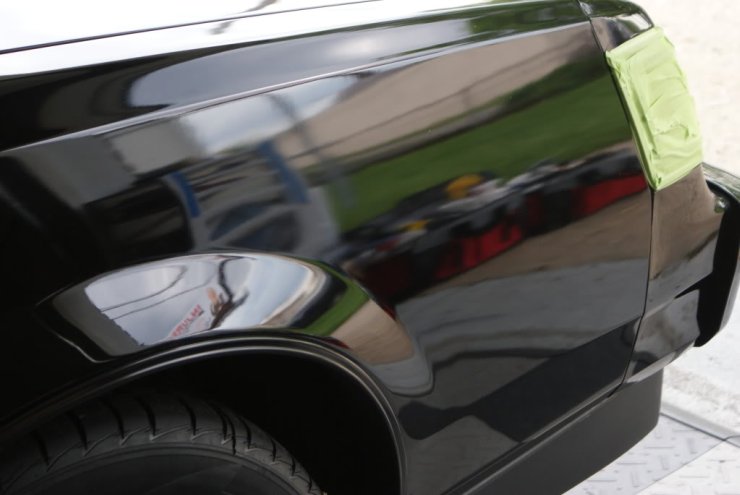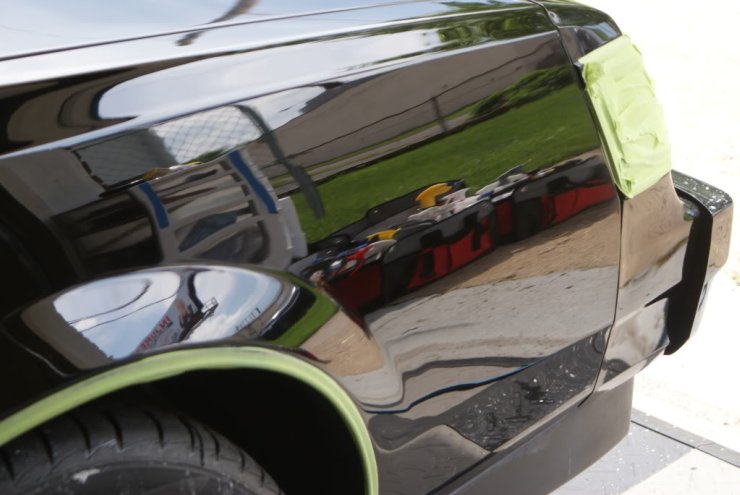Ask-A-Pro: Orange Peel Part One of Two – What is it and why is it a problem?
by Marc Harris & Jacob BunyanWhat is an orange peel and how do you fix it?
Thanks!
Anson L.
Anson,
Great question on something that affects the final result of how any car looks. While there is a short answer and a long answer, I hope to give a thorough answer that will you give you and other enthusiasts on what “Orangle Peel” is, how it is created, and options of dealing with it.
Ask-A-Pro: What is Orange Peel and How Do You Fix It? Part One of Two.
Orange Peel is the term commonly used to describe a finish that is not very flat for one reason or another. If you look at the surface of an unpeeled orange, you’ll notice the surface isn’t really smooth, rather it has obvious higher points and lower points.

When liquids are sprayed (primer-sealer, base-coat, clear-coat, etc), they are mixed with pressurized air in order to propel and “atomize” the liquid, that is, break the liquid into many small tiny drops that will reach the intended surface. The smaller the drops and the more smooth the air flow propelling them, the more even and smooth the painted surface will look. Also, as the little drops land on the surface, the flatten out (due to the adhesive bond on the paint drop and the surface, and gravity, or other means of creating attraction) and the more flat they settle before they dry; the smoother the finish will be. The more flat the paint lays, the more clear and crisp the reflections will be. This is also why an outstanding paint job is referred to looking “like glass.”
Dispite the optical benefits of a flat surface, almost all cars have a lot of orange peel when compared to cars manufactured just 10 years ago. While dealership sales representatives from various manufacturers have been quoted as claiming this is done on purpose “to help hide scratches”, the truth of the matter is likely much deeper than that.
Volitile Organic Compounds & Pollution
VOC laws have become more and more tougher across North America and Europe over the last several decades as national and local governments try to crub pollution and the long term effects of green house gases. While this is a good thing for our health and our future generation’s health, tougher laws mean less aesthetically appealing paint jobs out of the factory as paint restrictions allow for less and less VOCs. Volitile Organic Compounds are the parts of the paint that hold the pigment molecules in an even distribution to help transport the pigment through the air in a liquid form and onto the surface. Once the paint reaches the surface, the VOCs evaporate from the finish leaving the paint to become solid and dry. If you’ve ever been around a paint shop, you’ve likely smelled the VOC’s in the air as they evaporate giving off a strong solvent scent. VOC’s are used as carriers of particles: they suspend pigment agents, urethane, polyurethane, and other molecules that will be left behind once they evaporate away. They also allow the spray-able liquid to be much less viscous: that is they thin out the liquid solution to be less like honey and more like water. The thinner the liquid is, the easier it is to atomize as it comes out of the paint gun, and the more VOCs in the liquid: the longer it will take to begin to become sticky/tackey, and the longer it will take to dry. The longer it takes for the paint to dry, the flatter the paint will end up as the drops have plenty of time to settle into a flat surface. While it could be common for paints of the past to have 75%+ VOC content (that is, 75% or more of what you spray will evaporate away), many laws today force certain products to have up to a maximum 50% VOC content or even less.
The Future of Automotive Paints: Water-Based?
Some local governments / municipalities will begin to force OEM paint applications to use water-based base-coats (the thin layer of pigment under the clear-coat that provides color), or have already began forcing manufacturers toward this new technology. While the benefits include a large drop in pollutants in the air as well as a very fast drying time, these paints are still having the kinks worked out. Because the clear-coats being used are still solvent based, they don’t completely bond in the same way with the water-based layer they lay ontop of. Some owners of newer cars complain of abnormally high stone-chipping issues, but it is hard to prove is this is due to the new paint technology or not. In the future, we may very well see a move to completely phase out solvent-based products, but for now clear-coats continue to be solvent based as well as most “refinishing” products (body-shop AKA after-market paint jobs.)
Now that you know what orange peel is and a little about how it is formed, in the next Ask-A-Pro article we’ll discuss how to get rid of orange peel so you can go from this:

To this:

Stay tuned!
This article was written by Marc Harris of AutoLavish Fine Automobile Detailing from Michigan with further editing, clarification, and information provided by Jacob Bunyan of AutoLavish.









Thanks for the write up Marc. I know a lot of owners on AcuraZine have been wondering why their brand new Acura TSX has such a crummy paint job for a $30K+ car. So how is Ford able to minimize thier stone chip problem when Acura can’t even do that? Is it that Ford just adds another layer of paint?
Fabian,
Glad you enjoyed the article and I hope we included enough information to give a good understanding. I totally understand what you mean about some luxury car owners not being completely happy with their paint that’s less than two years old. Chipping is something that has gone on for years and will continue to happen. Many times with having a faster or more fun to drive car, people drive much more “spirited” and they also pay much closer attention to their pride and joy than they have to vehicles in the past. If you think the Acura owners aren’t happy about chips, go talk to the Caramo owners from Camaro5.
You say Ford seems to be minimizing chips – but are they really? I’ll be waiting to see what the new “5.0” Mustang owners have to say within the next year of how their paint is holding up to chips: especially if any use lowering springs or new coilovers. Ride height, paint color, the vehicle’s design, where you live, and how you drive all affect chips: but it’s much easier to point the blame elsewhere. If anything, I’d say if there truly is a chipping problem; it’s because of adhesion issues with water-based base-coats. When base coats were still solvent based, the primer surfacer, base-coat, and clear-coat were all solvent based which means they all bond extremely well to each other. I wouldn’t be surprised to hear that clear-coating over the new water based paint isn’t allowing for the same level of adhesion. Without insiders at places like DuPont or PPG chiming in to shed a little light (which they’ll never do as it may cause warranty issues to the manufacturers using their paint systems), we’ll likely never know.
Maybe I need to do an article addressing chipping problems on newer factory paint jobs….
I am looking forward to this article. Especially since it seems it was done on a Buick GN which I am getting ready to detail soon, so any information on improving the single stage black on these bad boys would be awesome.
Garrett,
Thanks for taking a look! The pictures are in fact from a Buick Grand National, but most of the paint was not the original single stage black. At some point this car was repainted, and while there wasn’t a lot of dust marks or fish eyes, there was a horrible amount of orange peel. Grand Nationals have infamously bad paint, and it is rare to find one with original paint that isn’t plagued with “crow’s feet” which can only be solved through a respray. Also be careful as I haven’t found one yet that doesn’t have very thin factory paint. The roof on this car was the original paint, and was only corrected to around 70% because of the large amount of defects and the extreme thin layer of paint that was still there. In that case; a huge difference is made by removing the oxidized chalky paint to leave glossy paint behind that could be protected by sealant/wax.
Thanks again for taking a look and stay tuned for the follow up article
Where is part 2?!?!
Marc is building a-n-t-i-c-i-p-a-t-i-o-n for it!
It’s coming Mo! I promise!
It will be up soon enough – the final touches have to be put on it, so stay tuned for part two of two
ok ok, i will keep waiting but i am running out of patience! haha, thanks in advance
I am with you Mo, I can’t wait for Part 2!
Oh man Mr. Harris, you have me excited for this write up. My car is a ’96 volvo and yeah it’s not as good looking as a BMW or a MB but to my eyes it’s beautiful so I’ve spent close to $200 on this site to get equipment to make it look beautiful. The only thing that’s missing is to get rid of the orange peel and if you can show me how to do that…. well…. me love you long time. :):):)
So how much longer for part two? It’s already been two weeks since you posted part one. I just hope it’s worth the wait and lives up to the hype.
I’ve seen on other sites that they’ve wet sanded the paint then went over with wool pads and then they detail the car as if it a were normal scratch/swirl mark correction job.
That is exactly how it works. Some things I’ll be covering is the importance of doing it right and the dangers you can get into if done wrong… along with a step-by-step process as an example of how it can be done of course.
Sorry for the delay guys! First off – I’ve been busy trying to make some nice automobiles beautiful again, and I’m sure you can understand that.
Next off, Part Two is coming along. Just as with proper detailing, I’m working to a standard – not to time. The goal is never to rush articles out so they lack in-depth information. Taking on the Orange Peel topic is something I feel is important, and is important to do right. Right now I’m shooting for the few few days of September as I’ll be in California for an old Army buddy’s wedding (it’s been planned since ’07 when we were in Afghanistan).
Thank you for the continued support and in the mean time, enjoy some of the current and coming great articles from the DI Ask-A-Pro blog members!
Thanks for the tips on the GN, it is still the original paint but it only has about 23,000 miles on it. Either way:
Number Two!!!
Any updates for the second part???
I enjoy these Ask-A-Pro articles that are longer and have pictures.
Thank you Allen, and I can assure you there are plenty of great Ask-A-Pro articles coming soon!
Can’t wait for part two.